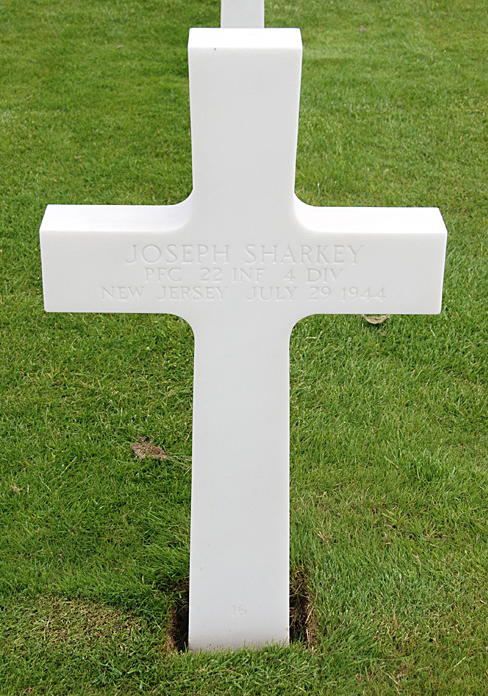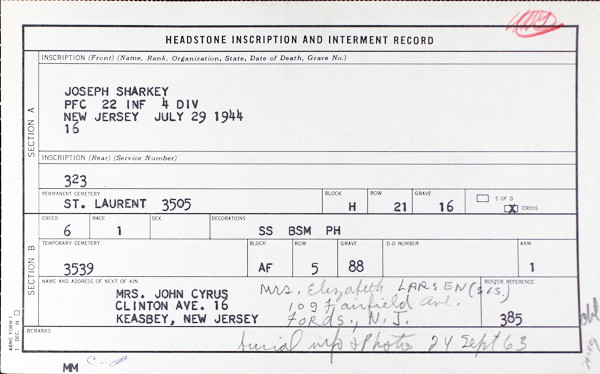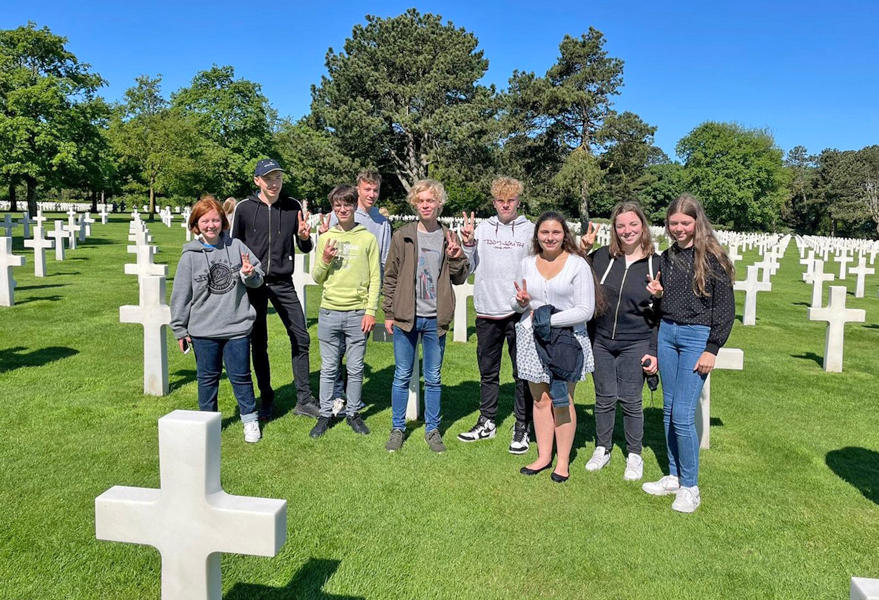 |
Grave marker for Joseph Sharkey Photo by Mike & Bushy Hartman |
Joseph Sharkey
Company C 1st Battalion 22nd Infantry
4th Infantry Division
DOW 07/29/1944
Joseph Sharkey was born in Keasbey, Middlesex County, New Jersey on September 30, 1911.
Before entering military service
he worked at the Cadalliac (Cadillac?) Shirt Company
in Perth Amboy, New Jersey.
His Army serial number indicates he was drafted into the Army.
Private First Class Joseph
Sharkey died on July 29, 1944, of wounds received in action in
France, on July 28, 1944
during Operation Cobra, the breakout from Normandy.
The following passage describes
the action in which Joseph Sharkey received his fatal wounds,
during the fight against German tanks and infantry in the village
of Moyon
( spelled as Moyen in the narrative.)
Two men of the
First Battalion, Captain Frank B. Reid, CO, Company C, and Pvt.
Sharkey, also of Company C,
merit special attention for their heroic actions during the
Battalion's attack on Moyen on 28 July. Undoubtedly
there were many other similar performances deserving of equal
praise, but the story of Captain Reid and
Pvt. Sharkey is indicative of all the fighting
men who distinguished themselves so remarkably in the face
of almost insurmountable obstacles. After penetrating the
northern part of the city of Moyen on the 28th,
the Battalion discovered that the enemy had strong tank forces
south of the town along with other entrenchments
and antitank guns. Captain Reid led a patrol of twelve men south
to a crossroads just east of the church to get a
German antitank gun. The crew of the gun was dispersed by rifle
fire and grenades, but immediately the patrol
received heavy machine gun fire from a German tank in the
distance. Captain Reid moved his patrol by circuit
to the north and east and came up on the right flank of the tank.
The ammunition carriers for the bazooka
had been lost by this time and the patrol had only two rounds of
bazooka ammunition. Pvt. Sharkey, known as
a "bazooka hound, " fired at the tank just across the
hedgerow and hitting it in the turret, knocked it out. A second
enemy tank now came up directly behind the one destroyed and
started blazing away from a distance of from 75 to
100 yards, whereupon Captain Reid leaned over the hedgerow just
above the tank and dropped two WP grenades,
one down the air vent on top of the tank and the other under the
tank, setting it afire.
A column of German
tanks, accompanied by infantry, was now coming along the road
towards the town, and they
opened a terrific volume of fire on the patrol. Pvt.
Sharkey stood on top of the hedgerow and fired the last
bazooka round
at the leading tank, hitting it at the base of the turret and
knocking it out. "Let's clear out of here before they zero
in on us,
" Captain Reid shouted to his men. But Pvt. Sharkey
remained standing on top of the hedgerow and fired at the
approaching infantrymen with his carbine until a burst of machine
gun fire from the tanks took off the whole side of his face.
It missed the bones of the jaw but left the flesh hanging down
over his chest. Pvt. Sharkey got up from the
ground
and walked away with the retreating patrol. The rest were
crawling across the field under the heavy fire from the
German tank column while Sharkey made the whole
trip walking upright.
As they reached
the road running east from Moyen, they found that another column
of German tanks had moved up
that road toward the town, and the leading tank was barring their
way across the road. The patrol now had no
ammunition other than two WP grenades, one fragmentation grenade,
and small arms ammunition. Captain Reid
threw the two WP grenades, one under the tank and one behind it.
The tank backed up, but it was already on fire.
Meanwhile, the smoke from the grenades formed a screen across the
road and under this cover the patrol got across
and rejoined the company, without Sharkey and
two other men whom Captain Reid had left to take care of Sharkey
while he got the remainder of his patrol to safety. By this time,
Sharkey had practically collapsed, and in the
brief
duration of the smoke screen, the other men were unable to lift
him over the hedgerow. However, the German tanks
had apparently been successfully frightened away; a little later
the three men moved down the road into town,
Sharkey again walking and holding up his finger
in the victory sign. "Sharkey made the
greatest display of guts
I've ever seen, " was Captain Reid's comment on the
incident. ¹
Joseph Sharkey was awarded the
Silver Star Medal in General Orders
HQ, 4th Infantry Division, G.O. No. 77 (October 19, 1944).
He was awarded the Bronze Star
Medal in 4th Division General Orders # 74,
dated 9 October 1944.
Joseph Sharkey was buried in the
temporary U.S. Military Cemetery
La Cambe Cemetery, Isigny, France in Block AF Row 5 Grave 88 and
was moved to the permanent
cemetery at Colleville-sur-Mer, during the period 1947-1949 when
the temporary cemeteries were shut down.
Burial:
Normandy American Cemetery and Memorial
Colleville-sur-Mer
Departement du Calvados
Basse-Normandie, France
Plot H Row 21 Grave 16
 |
Grave marker for Joseph Sharkey Photo by Mike & Bushy Hartman |

Headstone (grave marker) inscription record for Joseph Sharkey
Courtesy of John R. Tomawski

Julien Woestyn writes:
I went on a school trip with my classes
(from the Institut Saint-Henri Comines) in Normandy and we went
to the Colleville cemetery.
We visited different graves of 22nd RI soldiers and immortalized
this moment. Indeed, after telling the story of Joseph Sharkey,
the students wanted to reproduce one of his last gestures... the
"V" for Victory... (The grave of Joseph Sharkey is in
the foreground).
Photo courtesy of Julien Woestyn
¹ HISTORY OF THE
TWENTY-SECOND UNITED STATES INFANTRY in World War II
by William S. Boice (Self published) 1959
Home | Photos | Battles & History | Current |
Rosters & Reports | Medal of Honor | Killed
in Action |
Personnel Locator | Commanders | Station
List | Campaigns |
Honors | Insignia & Memorabilia | 4-42
Artillery | Taps |
What's New | Editorial | Links |